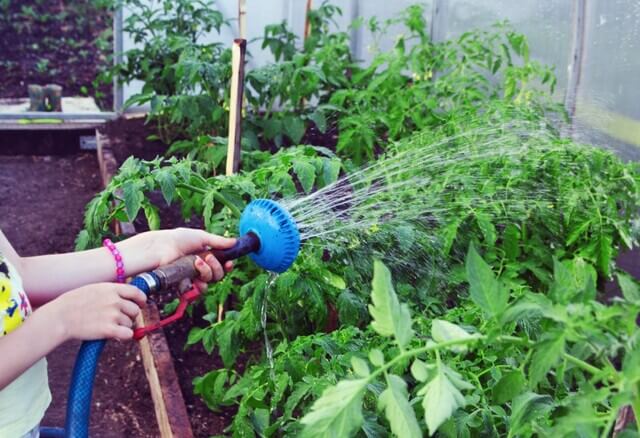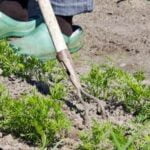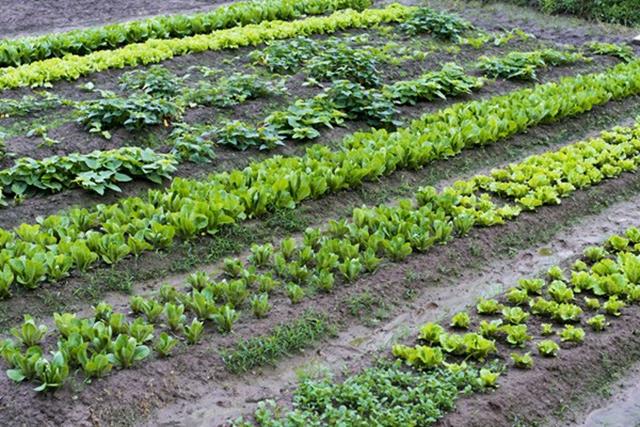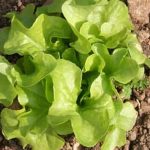
Not a lot of people try planting vegetable gardens these days, especially not in the city. What with the busy lifestyle, constrained spaces, and pollution, it seems inconceivable that a vegetable garden would survive. The fact is, you can actually grow them even if you are smack in the middle of a busy city. It’s only important that you get the basics of planting vegetable gardens right.
First things first. Soil preparation. This is one of the most basic things that any new gardener will have to learn. Whether you plan to use a plot of land in your backyard or start a vegetable garden in plant boxes, soil preparation plays an important role in whether your vegetable garden will survive or not. There are three types of soil that you need to be familiar with; sand, clay and silt. Sandy soil is loose and helps the roots of plants breathe because it lets the air pass through easily. Clay soil absorbs water faster and keeps it inside longer, a soil composition that has more clay particles in it would be ideal for places that are too hot and the soil dries up quickly. Silt is a fine mixture of sand and clay particles.
When preparing the soil for your vegetable garden, dig up the soil and break off the lumps. Take out the rocks, roots, and weeds while you’re at it. Check if you have just the right mixture of sand, silt, and clay before you begin planting vegetable gardens. Ideally, silt and sand should both be 40%, and clay should just be 20%, this is to make sure that the water isn’t trapped inside too much that the roots will choke. Also, if the water is trapped too long inside the soil, the roots will rot. One good way to test whether the composition of your soil is good is by scooping out a handful and forming a ball with it. The soil should hold the shape of a ball without too much difficulty. If the soil cannot hold the shape, you might have too much silt or sand in the mixture. If the soil holds the shape but does not crumble easily when you poke it, it might have too much clay in it which you need to balance out with a little silt or sand.
Once you have finished cultivating the soil where you want to plant your vegetables, pick what kind of vegetable you want to grow there. Keep in mind that some vegetables don’t grow well when you plant them too close to certain types of other vegetables. Potatoes, for example, shouldn’t be planted too close to squash or tomatoes because it inhibits their growth. They can be planted in the same garden, just don’t plant them beside each other.
After you have decided on the kind of vegetables you want and planting them into the cultivated soil, you’ll have to learn about how to water them properly. Vegetables need to be watered consistently. When planting vegetable gardens in a big space, you might want to consider using a soaker hose. A soaker hose has many holes along its body that waters your garden by letting the water seep through its holes.
Planting vegetable gardens require manual labor (yes, actual work), and a lot of patience. The rewards are very well worth it, though. Especially for people who are concerned about their health. Growing your own vegetables makes sure that there’s the least amount of poisonous (and in the long run, carcinogenic) particulates in it as possible.

Planning Before Planting Vegetable Gardens
In periods of financial difficulty, planting vegetable gardens becomes a viable option that achieves two things: it helps the family reduce expenses related to buying food, and it offers the opportunity to sell excess yield to friends and neighbours. Starting a vegetable garden is not particularly difficult, for so long as you put enough thought, time, and effort.
The first decision you have to make is the location of the vegetable garden. You must place this vegetable garden in an area where it is exposed to at least 6 hours of sunlight. The location must also be near where you will source the water you will use to water the plants. It must be near enough for you to make a short trip if you are carrying a pail of water, or it must be near enough to be easily accessible to the hose you will connect to a faucet inside your home. Also, check if the area has soil conducive for growing plants. It must have good drainage, and must be free of silt, stones, and other hard objects. Lastly, the location of your vegetable garden must be somewhere accessible, so that you can frequently check for pests and weeds when you walk by.
Included in your plans should be the sort of plants that you intend to plant, and how many of them you intend to grow. This will help determine the size of the plot you will need. Afterwards, make a list of all the plants you want to grow in your garden. This decision cannot be completely random, especially because the yield of the garden will be what you will consume as a family. Make sure to plant vegetables that your family would love to eat, or vegetables that you often use for cooking. This way, you are ensured of a direct benefit from growing your own vegetable garden.
Make a plan for the arrangement of the vegetable plants in the garden as well. The first consideration is the frequency of yield. Perennial plants, or those who yield vegetables for constantly throughout the year must be placed at the back of the garden, where it will be undisturbed by whatever gardening activities you may have in the rest of the garden. Put the crops that produce early yield together. These crops include radishes, spinach, carrots, beets, and the like. Make some space for replanting successively. Once these crops have seen their yield, you can plant in their place crops that produce yield later in the season.
The last consideration for arrangement is the reality that there are plants that cannot grow beside other plants. For instance, there are those plants that enhance the growth of another when planted together; there are those that inhibit the other. It is important to take into consideration which crops inhibit the growth of the other. For instance, potatoes are capable of inhibiting the growth of both squash and tomato plants. Broccoli also inhibits tomato growth. Beans, on the other hand, inhibit the growth of onions. Carrots also inhibit the growth of dill plants. This does not stop you from planting all these plants in the garden. This only acts as a reminder of which plants you should separate from the other when planting vegetable gardens.

Long-term Plans for Planting Vegetable Gardens
A lot of people are beginning to see the benefits of planting vegetable gardens. It’s usually healthier because you get to decide whether or not to use commercial pesticide on them. Since vegetable gardens are typically manageable in size because they’re not grown for profit, it’s easier for people to manage the plot without having to resort to using commercial pesticides. Vegetable gardens also assure you of fresh produce because there’s no need to pick the vegetables and refrigerate it. Vegetables stay fresh as long as you don’t pick it from your garden, except if it becomes overripe. Aside from health reasons, planting vegetable gardens is also economical because the produce is not going to be as expensive as those that you buy from markets or groceries.
People who have been successful in planting vegetable gardens usually know that you can’t keep growing only one type of vegetable in a garden. It’s usually more advisable to rotate crops instead of planting only one kind of vegetable year in and out. Rotating crops will make sure that the micro nutrients in the soil will be preserved, and that diseases will not build up in soil particulates.
Planting vegetable gardens take some careful planning on your part, and also an understanding on plant families to know which vegetable types are compatible with each other. These are some examples of groups that can be considered “compatible” and are safe to be rotated together:
Alliums – onions, leeks, shallots, and the likes Crucifers – such as radishes, turnips, broccoli, cauliflower, and the likes Brassicas – brussel sprouts, mustards, cabbages, kale and the likes Legumes – peas and beans Cucurbits – cucumbers, squashes, melons, etcetera Solanaceae – peppers, eggplants, tomatoes, and the likes Mescluns – arugula, endive, radiccio, etcetera
Rotating vegetables of the same family would also mean that (more often than not) they would be susceptible to the same kind of pests. This makes pest control a bit more manageable for you since you don’t have to adjust to different types of pests for different families of vegetables.
Vegetables such as asparagus, rhubarbs, and other perennial vegetables must not be rotated. They should be planted separately because of this. The more hardy and semi-annual vegetables can be rotated yearly so that no family of vegetables is planted in the same bed for four years. If you have done some planning before planting vegetable gardens, a small plot would like similar to this: four beds for plants that can be rotated, and one bed for perennial, non-rotating plants.
It would also be ideal for people who planning on planting vegetable gardens to spread out the kinds of vegetables they plant so that they don’t harvest too much of the same vegetable in one season. You wouldn’t want to be stuck with too many cucumbers in one season, would you? Throughout the growing season, try and plant varying types of short-season vegetables so that you’ll be assured of many different types of vegetables throughout the season.
If you really plan to get the most out of planting vegetable gardens, it’s best if you do your research first. Check which plants go together, check whether you have enough space to rotate your plants, check which plants you can actually rotate to prevent poisoning and depleting the nutrients of the soil, and spread out the type of vegetables you plant so you won’t have too much of the same thing for the whole planting season.

Save Money and Get Healthy by Planting Vegetable Gardens
Instead of setting up a swimming pool or a Zen garden in your backyard, why not plant vegetables instead? Planting vegetable gardens is a great way to spend a quiet time de-stressing while getting in touch with nature. Having a steady supply of vegetables will also lessen food expenses and improve the health of your loved ones.
Money-saving strategy
It’s not easy to ignore the soaring prices of food items these days, including vegetables. Although your backyard may be small and your vegetable garden may not provide all that you need, it will have a dramatic effect in reducing your food bill. Imagine not having to run to the grocery store to buy some of the ingredients for your cooking. Some of the most common vegetables that you need are already right there in your very own backyard. Depending on the kind of vegetables you plant and your methods of preserving them, the economical benefits you get from your vegetable garden may be felt all year round.
You may also think that your kids will likely to eat less each time your serve them vegetables. It is obvious that kids would prefer to eat burgers, hotdogs and others. However, there are several cookbooks available in bookstores that can show you a variety of vegetable meals to prepare that are appetizing even for the kids. When what you serve on the table does not look and taste boring, your kids will surely dig it.
More nutritious meals
With a variety of vegetables practically ready to pick right in your backyard, you will find it more pleasing to cook and serve vegetable dishes to your family. This means that everybody will get to enjoy the numerous health benefits of eating fresh produce, since vegetables are packed with tons of nutrients. Aside from the fact that they are low in fats and calories, and contain no cholesterol, you will also get a steady source of the following:
• Dietary fiber – This is important for normal bowel movement and good for your entire digestive tract. Dietary fiber is also known to reduce the amount of bad cholesterol in the body, lower the risk of heart diseases, as well as fight off certain forms of cancers. If you are on a diet, you will also feel much fuller faster. Some vegetables rich in dietary fiber are peas, carrots, cabbage and spinach.
• Potassium – This is necessary for keeping blood pressure at a normal level. It is also important in keeping the brain, muscles and other tissues in the body functioning normally. Vegetables that are loaded with potassium include potatoes, squash, tomato, eggplant and celery.
• Vitamins A, B and C – Vitamin A is great for the eyes and skin. Vitamin C is necessary to maintain healthy connective tissues and is known to boost the immune system. Vitamin B is important for extracting the energy in the carbohydrates in several food sources. Carrots, asparagus, broccoli and green pepper are rich in Vitamin A. Broccoli, peas and beans are a great source of vitamin B. Your dose of vitamin C is supplied by red cabbage, kale, parsley and turnip.
Other vitamins and minerals you can get from vegetables include calcium, phosphorous, sodium, magnesium, iron, niacin, folate, zinc and manganese.
Save money and help your kids stay in the pink of health through planting vegetable gardens. Plus you get that sense of pride each time your family enjoys the meal on the table, whose vegetable ingredients you cultivated yourself in your backyard.

No Backyard? Try Planting Vegetable Gardens Indoors!
Nothing beats the fresh wholesome taste of vegetables freshly picked from your own garden. Planting vegetable gardens can be a challenge if you don’t have a backyard, but you can still grow vegetables indoors. Just follow a few simple garden-smart guidelines.
Choose Appropriate Vegetables
Different plants have different requirements and with indoor gardens the major restrictions tend to be available space and available light. If you want to grow fruit bearing plants, these will require large amounts of sunlight. Salad greens like lettuce, miniature cabbages, swiss chard, and spinach require less light and do quite well indoors.
The size of your pots will also determine your choice of plant, choose containers big enough for the plants full growth. Small root crops such as radishes and onions are great choices, and there are even small root carrots available. Herbs are a popular choice because they are compact and do not need much space. Miniature varieties of tomatoes, peppers, and eggplant can also thrive inside when given the proper care.
Find the Perfect Spot for Growing
As mentioned earlier, lighting is an important consideration for an indoor vegetable garden. A bright south-facing window is your best bet, but any spot that gets a minimum of 5 hours of continuous light can be used. In addition to natural light, you can set up supplemental artificial lighting if you are really serious about growing healthy plants.
Traffic flow is also another important factor to think about. Vegetables in general bruise easily so you want to choose fairly quiet spots so minimize accidental human contact. If you have small children or pets at home, you may want to locate your garden well out of their reach. It is also important to think about proximity to your gardening tools and easy clean-up if things get messy.
Optimize the Microclimate
Plants grow best in high humidity and moderate temperatures. Indoor gardens usually suffer from low humidity and this needs to be addressed. Container grown plants tend to dry out faster and will require more frequent watering. However, it is important not to let the plants get waterlogged as this may cause root rot. Make sure that there is good drainage by raising pots with a pan of gravel underneath. Evaporation from these dishes also improves humidity so they serve a dual purpose.
Another great way optimize your microclimate is to group plants together. You can mix your vegetables with more decorative houseplants to create groupings that are not only beautiful but also functional. Temperature is actually easier to control inside the house, as it is easy to provide more shade by simply drawing the curtains. Just make sure plants are protected from drafts.
Get Good Potting Soil
Potting soil for indoor gardens should drain well and contain the nutrients required to support growth and development. You can purchase premixed potting soil that already incorporates the proper amount of fertilizer. If you prefer to go organic, you can get organic potting mixes from your local garden shop. Add nutrients with caution, as fertilizer buildup is quite common in containers.
Planting vegetable gardens indoors can be incredibly rewarding, so do not be afraid to give it a try. You may even end up growing enough produce to give as gifts to delighted family and friends.

If you’re looking to get into vegetable gardening, or are just looking for some tips on how to make your current garden better, then you’ve come to the right place! My name is Ethel and I have been gardening for years. In this blog, I’m going to share with you some of my best tips on how to create a successful vegetable garden.




